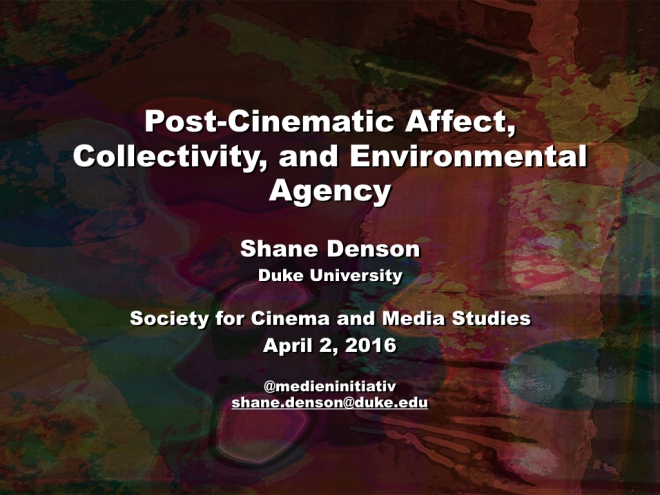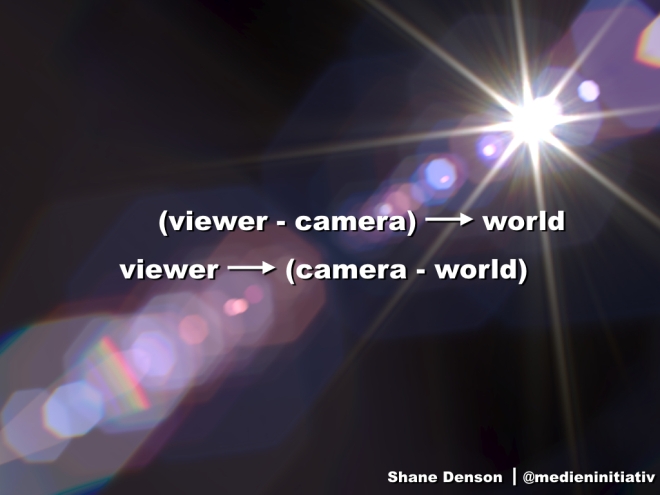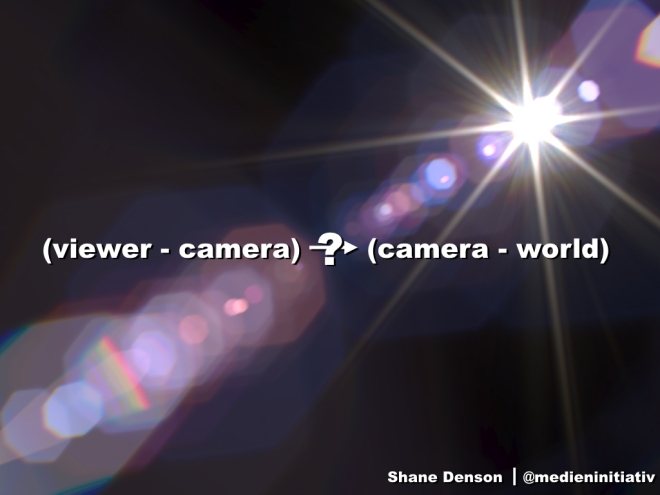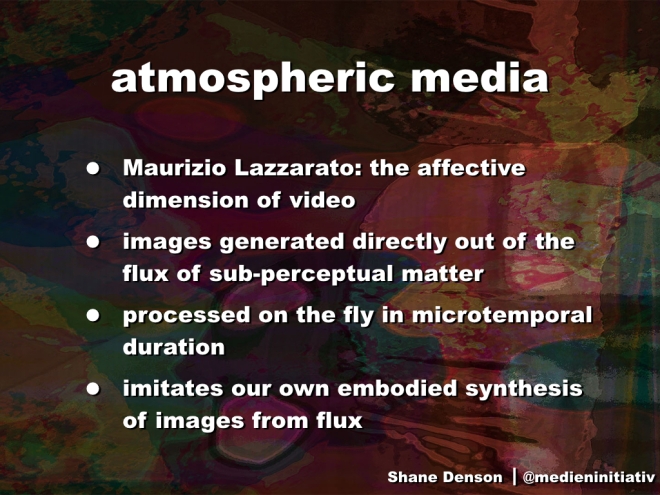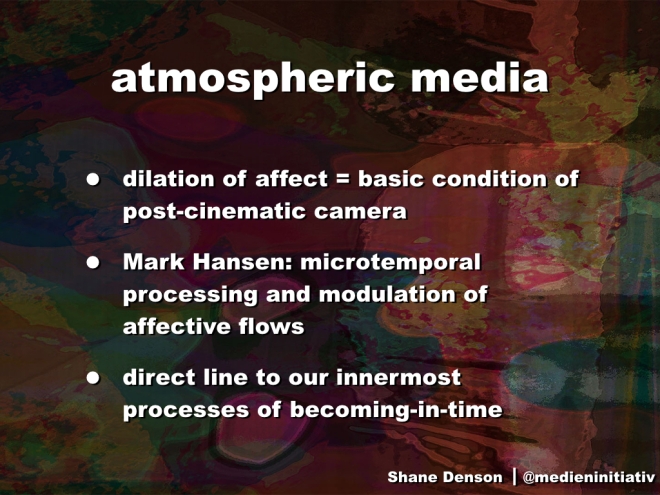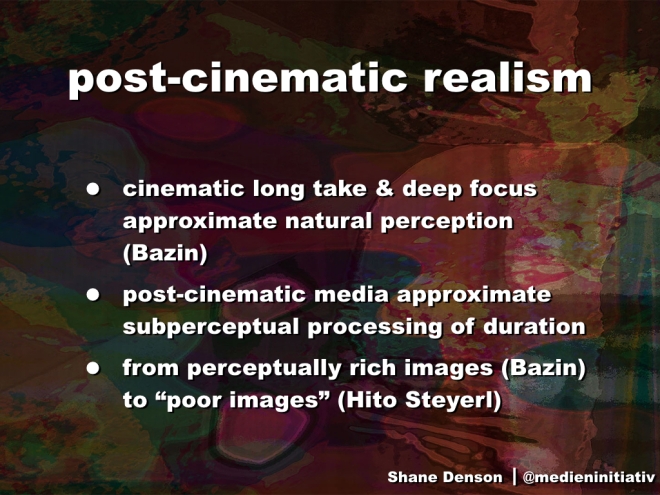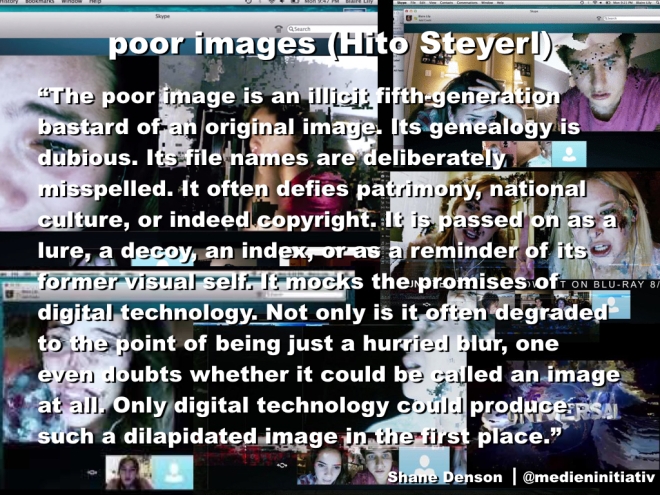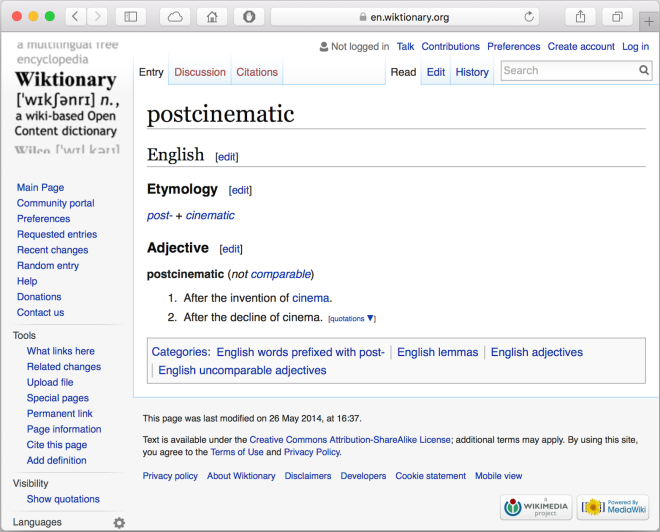Full text of my response to a panel at SCMS on “Post-Cinematic Control,” with papers by Lisa Åkervall and Gregg Flaxman:
Post-Cinematic Control: A Response
Shane Denson
It’s an honor and a pleasure to offer a response to this panel on “Post-Cinematic Control” and thus to set the stage for our discussion. Before I get started, I would like briefly to thank Lisa Åkervall for organizing the panel, and thanks to both Lisa and Gregg Flaxman for their excellent papers.
What I want to do is to think about the common base or context that unites these papers. I’d like to start by turning to the panel description that Lisa wrote as part of the proposal process, which I think neatly sums up the overarching questions and perspectives brought together here. She writes:
Today, scholars and critics often allude to a new technological, economic, and even epistemic age, but what is the medial logic that characterizes our brave new world and how has it transformed the very nature of audio-visuality? This panel is dedicated to analyzing the integral function of media in the emergence of the social form that has come to be called “control society”; in particular, the papers brought together here dwell on the “post-cinematic” cultures of image, sound, and affect in control societies. Where “disciplinary” power had previously worked to distribute, segregate, and organize bodies, “control” refers to a relatively fluid space of social relations. The dissolution of institutional milieus (home restriction, privatized HMOs, remote labor, home schooling) is inextricable from the emergence of a new post-disciplinary organization of power. We maintain that, far from concentrating power (in a sovereign) or consolidating it (in social institutions), control relies on post-cinematic media to disseminate power into the most private and unsuspecting of spaces, making its individuals knowable, calculable, and thus controllable.
Hence, this panel is concerned with understanding different dimensions of control by virtue of different aspect of post-cinematic media. More precisely, each paper examines aesthetic instances in which cinema persists as an echo rather than an actuality, whether this entails electronic voice modulation, instantaneous communication, or even the metamorphosizing nature of the cinema itself.
There are a number of things that can be said about this description, but I’d like to highlight and unpack just a few of them.
First of all, the panel is asking about the “medial logic” of our age, and this medial logic is credited with transforming “the very nature of audio-visuality.” Accordingly, this logic of post-cinematic media is seen to be located at an ontological level that is foundational with respect not only to media “contents,” but also to the processes of perception itself. If I am reading this correctly, that is, the transformation of “audio-visuality,” or stronger: the very nature of audio-visuality, cannot be reduced to a change in the objective forms of audio-visual media; it’s not just about new narratives, editing styles, or even image types – but it concerns rather a modulation of sight and sound as sensory channels, or perhaps even a transformation of phenomenality itself.
It is for this reason that the question of post-cinema’s medial logic is here given priority over questions of “a new technological, economic, [or] even epistemic age” – because any medial logic, or any force whatsoever that might be capable of such global modulations, cannot be reduced to the objective or subjective forms of causal processes, rules, rational choices, or knowledge formations. The medial logic at stake here concerns a level of reality that lies deeper than the subject, deeper than its objects, and deeper than any intentional relations between them. It concerns what I have termed the anthropotechnical interface itself: “a realm of diffuse materiality . . ., the relational substrate which underlies the socially, psychically, and otherwise subjectively or discursively organized relations that humans maintain with technologies” (Postnaturalism 26).
Seen thus, as I have written elsewhere, post-cinematic media
serve not as mere “intermediaries” that would relay images neutrally between relatively fixed subjects and objects but . . . act instead as transformative, transductive “mediators” of the subject-object relation itself. In other words, digital and post-cinematic media technologies do not just produce a new type of image; they establish entirely new configurations and parameters of perception and agency, placing spectators in an unprecedented relation to images and the infrastructure of their mediation.
The transformation at stake here pertains to a level of being that is therefore logically prior to perception, as it concerns the establishment of a new material basis upon which images are produced and made available to perception.
(“Crazy Cameras, Discorrelated Images, and the Post-Perceptual Mediation of Post-Cinematic Affect”)
Or, as Mark Hansen has added, upon which they are NOT made available to perception.
In fact, this addition is essential to the perspective being outlined here, which renders the study of post-cinematic media in many ways a speculative undertaking concerned more with ontology than with psychology, but this does not at all mean that it is doomed to being an apolitical perspective. For at stake in these investigations is precisely the material basis of what has been called subjectivation, the material and political process of becoming-subject, which requires for its control, steering, or modulation, the operationalization of forces that are by definition sub-personal or pre-subjective. Accordingly, with post-cinema we enter into
a fundamentally post-perceptual media regime. In an age of computational image production and networked distribution channels, media “contents” and our “perspectives” on them are rendered ancillary to algorithmic functions and become enmeshed in an expanded, indiscriminately articulated plenum of images that exceed capture in the form of photographic or perceptual “objects.” That is, post-cinematic images are thoroughly processual in nature, from their digital inception and delivery to their real-time processing in computational playback apparatuses; furthermore, and more importantly, this basic processuality explodes the image’s ontological status as a discrete packaged unit, and it insinuates itself . . . into our own microtemporal processing of perceptual information, thereby unsettling the relative fixity of the perceiving human subject. Post-cinema’s cameras thus mediate a radically nonhuman ontology of the image, where these images’ discorrelation from human perceptibility signals an expansion of the field of material affect: beyond the visual or even the perceptual, the images of post-cinematic media operate and impinge upon us at what [I have] called a “metabolic” level.
(“Crazy Cameras, Discorrelated Images, and the Post-Perceptual Mediation of Post-Cinematic Affect”)
These are issues that Maurizio Lazzarato has dealt with under the heading of a “video philosophy” – a philosophy of what he calls “machines to crystallize time.” These machines, which are exemplified in the video camera and further perfected in the digital processor, have a direct line on our becoming-in-time, as they operate at a speed that outstrips our cognitive processing and, on this basis, in fact modulate our perception itself.
The question of “control society” is thereby linked to these sub-phenomenal modulations, where the sub-phenomenal subtends and transforms the realm of the phenomenal by enabling new forms of audio-visuality in post-cinematic media. On the one hand, these new audio-visual forms are imbricated in the mechanisms and networks of control, but on the other hand, they offer us sensory spectacles upon which basis we can inquire and speculate on the anthropotechnical and sociotechnical interfaces being mobilized in contemporary subjectivation processes. In other words, these new audio-visual forms might serve as something like what Whitehead calls a “lure for feeling”; we can look to them to discover, speculatively, the operational agencies at work in the constitution of contemporary agency itself.
There is a kind of displacement, a non-actuality, a lack of positivistic self-presence, or what Derrida might call a “spectral” logic implicit in this view of post-cinematic mediation. This is reflected in the panel description in terms of the echo-like relation posited between cinema and post-cinema: “cinema persists as an echo rather than an actuality.” To begin with, this statement militates against ideas of caesura, or the death of cinema, by designating the cinematic as a quasi-virtual moment, a kind of memory-image that supplements and explodes the confines of a punctual present or a concluded past. But the echo, as echo, itself resists confinement to past and present, it is always experienced as movement forward, into the future that it contains and anticipates in its reverberations. Accordingly, we need to supplement this perspective: post-cinema’s relation to cinema is not just one of retention but also protention. It implies what Mark Hansen has called a “feedforward” logic, which is very much the medial logic of control itself.
Again from the panel proposal: “control relies on post-cinematic media to disseminate power into the most private and unsuspecting of spaces, making its individuals knowable, calculable, and thus controllable.” I have claimed that post-cinema, with its microtemporal processing, produces essentially post-perceptual images; here, what Deleuze called the “dividuality” of formerly discrete subjects is enacted at the level of the perceptual object, which is no longer stamped as a discrete photographic entity but modulated as a variable and infinitesimally divisible quantity. The post-cinematic image is generated on the fly, by means of processes that are dependent upon codec settings, available processing power, bandwidth limitations, and buffering, so that the pixillated images we see on our digital devices are in a very real sense data visualizations. And all the while they generate a further stream of data or metadata that delivers information about our attention and perception to corporate interests like Google, Facebook, Microsoft, or Netflix. This metadata, it should be pointed out, is not “meta-” in any metaphysical sense of a detached second-order register; in many ways, it is the primary data, while our sense data is secondary or supplemental for the purposes not only of the money-making machine but also for the production of sense data to come. Futurity is implied in this equation in a way that explodes the simple feedback loop as we have known it. This is not about surveillance, but about control in a newer, non-deterministic and non-disciplinary sense. Wendy Chun reminds us: that “the English term control is based on the French contreroule—a copy of a roll of an account and so on, of the same quality and content as the original” (Control and Freedom 4). As a verb, to control enters into Middle English in the sense of to “to check or verify accounts,” in particular by referring to a duplicate register. But in post-cinematic media the idea of the register, the record, or the memorial function more generally of control shifts to a future-oriented, protentional one, whereby the subject of perception is actively anticipated or called into existence by means of microtemporal calibrations of data and sensory streams.
Portending the future, or better: protending it, these media synthesize time or becoming through the real-time generation of data that point backwards and forward at once. Perception itself is dispersed, along with the data of its generation, between here and there, now and then, between the two rolls or scripts, where the acts of reference and correlation between them explodes the static “now” of either one and enables the generation of new experiences and affects in real time (or, what amounts to the same, in a microtemporal duration that is outside the window of subjective perception).
This, indeed, is the temporal truth of Autotune, as it is explored in Lisa’s paper “The Truth of Autotune”: a real-time input (an audio signal) is analyzed and compared to a set of possibilities (the discrete notes or values inscribed on the contreroule or control script), subjected to modulation accordingly, and made to correspond to the acceptable values before the signal is even made available for perception. Past, present, and future are synthesized here, their discrete natures dissolved in the interplay of script and counter-script. Of course, it is possible to analyze the situation logically or algorithmically, and to study the exact path of the signal with the help of technical instruments, so that we might claim that it only appears that time is subject to transformation. But since it falls beneath the temporal threshold of perception and thus undercuts or bypasses appearance itself, this microtemporal processing does indeed revolutionize time for all intents and purposes – which is to say, for all human intentionalities and telic goals, which are structured in the molar temporal space of gross phenomenality.
And the microtemporal ping-pong that characterizes the Autotune process also conditions digital images in computational video playback, which is especially evident in processes like motion smoothing, where new images are generated on the fly and interpolated between a just-past image and one that is just-to-come, which means that both of them must be assessed and processed before any image is made available for perception.
But how do we get from these low-level processes and infrastructural materialities to the higher-order, sometimes global, and in any case narrative formations discussed by Gregg in his paper “Conspiracy in the Age of Control”? In fact, it’s not such a stretch, I suggest, as these stories of conspiracy and control place computational processes at the very heart of the struggles over political agency and resistance, and they invite us to reflect on the ways that these apparatuses serve as the fulcrum of subjectivation itself and the site of communication between micro-scale materialities and macroscopically narrativizable or cognitively mappable realities.
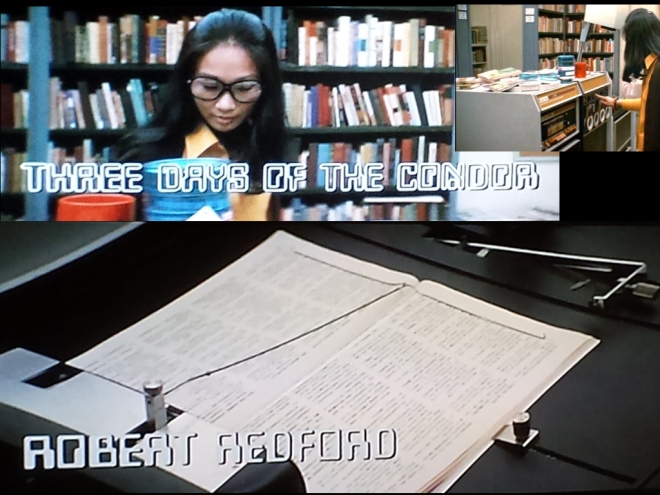
Three Days of the Condor opens with images of a machine for “reading” books, enacting a sort of “distant reading,” as Franco Moretti calls it, by which thousands of books are processed and correlated with one another to reveal humanly inaccessible patterns. Soon we find out that this work is being done for the CIA, thus exposing avant la lettre what Richard Grusin has called “the dark side of digital humanities.” The protagonist, codename Condor, is both a hermeneut and an expert in communications technologies, and it is this combination that not only makes him a digital humanist, of sorts, but that equips him to negotiate between local subjectivities and global networks of conspiracy. His political agency, as Gregg emphasizes, hinges on his cryptographic skills, his ability “to render narrative what might otherwise be noise, coincidence, or nothing at all.” As such, the story is precisely about the media-technical linchpin between a material base or infrastructure of experience and the aesthetic forms it can assume. Confronting us allegorically, as Jameson says about conspiracy movies generally, with the sprawling architecture of the global system of transnational capital, Three Days of the Condor simultaneously confronts us with its computational media-technical underpinnings. The reading machine at the opening of the film is the infrastructural point of passage to the dispersal of agency described with the term “control society.”

And it is in this respect as well that the Bourne movies can be seen, as Gregg has suggested, as an unwitting update of Three Days of the Condor: for not only are these movies about an intensified system of global, dispersed control, but they hinge the question of subjectivation processes on the infrastructure of computation, big data, and – crucially – a global network of cameras, screens, and images. At decisive moments, the film screen becomes, as Gregg puts it, a “data screen.” And here we see that Condor’s struggle (to render machinic information into narrative form) is in fact one of the defining struggles of post-cinema more generally: it is the problem of how to build narrative strands out of (and back into) sprawling transmedial digital networks. In other words, Condor’s reading machine and the reading practices it leverages (which confront mathematical communications technologies with the demands of a hermeneutic or narrative/representational interest) prefigures the network of computers and digital video surveillance cameras featured in Bourne. In many ways, these are self-reflexive spectacles, such that post-cinema figures its own enabling infrastructures and challenges us, in this way, to confront the political processes of subjectivation that inform life today and shape it from the media-technical ground up.
